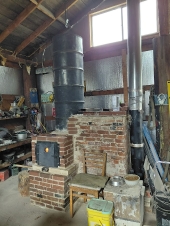In the early days many people insisted that a normal vertical chimney was not needed,now most people involved in the making of rocket mass heater seem to think it is best practice to use these kinds of chimneys.
It's good to know that most people are now realizing a vertical chimney is necessary to achieve a good safe draft. I think you need a good draft just to start a fire, if you don't want a face full of smoke, and it needs to get hot fast to heat the chimney and establish the draw.
I think if you remove the issue of horizontal movement and extracting ALL of the heat before exhaust then you have removed any issues I might have.
Yes, I suppose some might see it as wasting heat, but it is critical that the chimney itself gets hot and stays hot. Our masonry chimney,
not on an outside wall, itself, works as a mass heater. My little wood stove puts off a pretty good roar if it's cold enough outside to warrant it. So, I guess I already have a rocket mass heater, of sorts.








